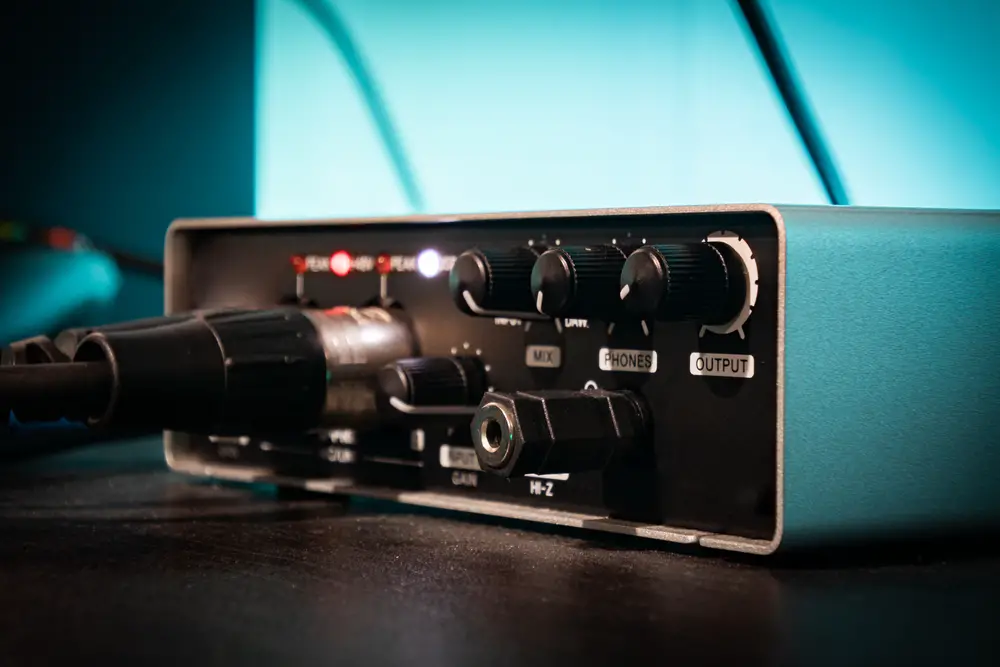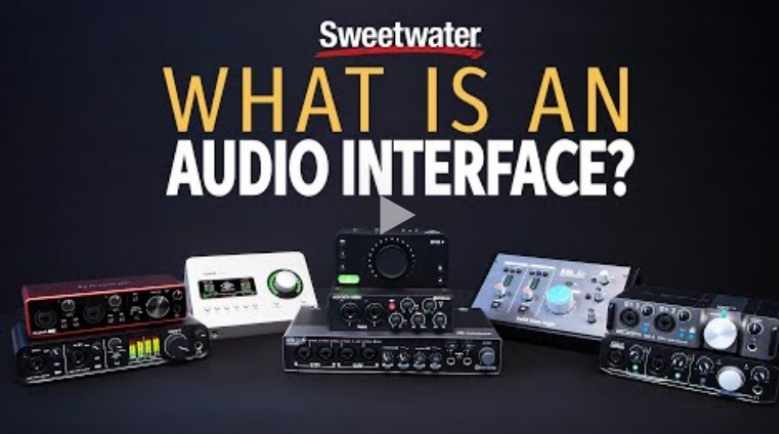If you are a seasoned musician or proficient with an instrument and want to start recording your music rather than playing through an amp for your enjoyment, you may have heard of an audio interface.
An audio interface is another tool for the modern artist and is pretty inexpensive, which allows you to enter the digital world of music production and recording.
Audio hardware can often be confusing if you don’t know the basics and aren’t a sound engineer. It can be important to learn the mechanics and operation of a piece of hardware before you endeavor to purchase one for your own use.
Whether you are a sound engineer or making your start as a recording artist, then an audio interface could be the next step in your musical career, so read on if you want to learn more about audio interfaces.

What Is An Audio Interface?
In the past, an independent recording was basically impossible. You usually had to pay a lot of money to go to a recording studio to be recorded within a physical space.
Imagine how many artists’ careers have been quelled in the past by technology not keeping up with the artist’s imagination. Audio Interfaces are a product that grew from the digitization of music back in the late 1980s and 1990s.
By the mid-1990s, the common household computer could now record multi-channel audio within 16 bits.
An audio interface is a piece of hardware. It converts an instrument or microphone signal into a signal that your computer recognizes. This means you can record and listen to playback directly from your laptop.
The interface will usually connect your laptop with USB cables, and you can plug your guitar cable straight into the audio interface like you would an amp.
The most simple audio interface to comprehend is a microphone. If you plug a microphone into your computer and record audio, this functions exactly the same as an audio interface does.
But sometimes, it’s not so simple to simply plug a microphone or instrument into your computer, and the audio interface solves this problem.
The new technologically advanced audio interface could potentially record a whole band with the help of multiple channels, with only one piece of hardware!
An audio interface differs somewhat from a mixer and while functionally overlapping. An audio interface is intended to communicate directly with a digital workstation where the interface digitizes the sound inputted into it.
Conversely, a mixer will have physical controls for the equalizer, faders, etc. In contrast, an audio interface simply converts the inputted sound into a format that can be edited on the host device.
In the modern age of digital technology, there are some technological developments to be aware of. For instance, some of you may know that Apple’s devices don’t have USB ports; instead, they have an alternate input system called ‘Thunderbolt.’
Rather than being difficult for difficulty’s sake, Apple is actually focused on the speed of their devices rather than simply being different. What is meant by this is that the thunderbolt system is faster than your regular USB.
What this means for your audio interface is what is known as latency.
Latency is essentially the speed at which the sound wave created by your instrument can be input through the audio interface, in-built pre-amp, etc., and back out through your headphones or sound system.
Put simply, this means the milliseconds between you hitting a guitar string, for example, and you hearing it in your headphones are reduced.
While this is a tiny detail, it can be really important to some musicians and essentially rules out the chance of any lag between playing a string and hearing it back.
The Thunderbolt’s speed does actually make it preferable to a USB input; however, Apple’s Thunderbolt system isn’t universal yet, and many people still use USB ports.
But when you are purchasing an audio interface, it is well worth keeping in mind what inputs and outputs you use.
If audio latency is something that matters to you, then consider Thunderbolt. If you use a Mac or Apple device, the Thunderbolt is your only option beyond buying a USB adapter.
What Does An Audio Interface Do?
As the audio interface converts the inputted sound into digital audio, this digital audio file can now be freely edited within an audio workstation such as ProTools or Ableton.
These audio workstations allow you to cut the audio file up, view the audio file within a beat grid, change the files BPM, apply effects and ultimately create a song with multiple audio files.
For example, in the digital age of music, the ‘autotune’ epoch has loomed over the modern music industry since it became a mainstream tool for music producers. An audio interface is the hardware foundation of this process.
The audio inputted into the microphone is converted into a digital audio file. This digital audio file is then put through a processing or editing software on a digital workstation that manipulates the audio within the parameters of what is known as ‘autotune.’
This, now edited, audio file can then be played through the audio output with this effect on it, allowing a performer to sing live while having effects on their voice.
If you didn’t have an audio interface, you could record audio directly through your laptop’s built-in microphone, but this won’t be of high quality.
In What Situation Do I Need An Audio Interface?
If you want to record high-quality audio, you will likely need an audio interface. The other option is the built-in microphone on your device, which is not high quality.
In the same vein, you could record your guitar or bass directly through the built-in microphone on your device, but this would also significantly reduce the audio file’s quality.
Similarly, if you are thinking about starting a podcast, you will also need to purchase an audio interface.
Obviously, you don’t need to alter the audio file for podcasting significantly. Still, an audio interface gives control over channels and also lets you record audio in high quality.
You may want a ghost channel for a producer; an audio interface allows users to choose which channels are muted or recorded.
Moreover, if you have multiple guests, you may want audio playback through headphones so that you can hear each other. This can be achieved with the correct audio interface.
Ultimately, with the use of an audio interface, you will be able to record and edit the audio files on an audio workshop creating a high-quality audio file that you can upload.
How Much Does An Audio Interface Cost?
When pimping out your home studio, it’s vital to keep costs in mind, especially if you want high-quality instruments to record on as well.
The price of an audio interface will change depending on how many channels it has and control over those channels, which ultimately depends on the purpose of using an audio interface.
Ultimately, you should choose the interface that enables you the control you want, whether that’s having multiple channels and headphone controls, or you simply want high-quality audio for a 2 in 2 out system.
For instance, an audio interface for podcasting will need multiple channels and physical mixing tools for live editing. This will naturally cost more The Rode RODEmaster Pro is a particularly sought-after audio interface that is tailor-made for podcasting.
This product costs around $600-$650. Other products’ prices will vary based on their quality and features. This audio interface is perfect for both professional and amateur podcasters.
Comparatively, your common audio interface which is purely for recording purposes, can range from $50-$200 depending on what you want.
The Roland Rubrix 22 is a popular audio interface for recording with two inputs in and two inputs out. This comes in at around $150 and is perfect for a home studio or simply for the bedroom DJ.
Final Thoughts
An audio interface is one of the most significant technological developments within audio recording. It allows almost anyone to record audio easily and with the sound quality of a recording studio.
Audio interfaces have launched many modern musicians’ careers and have made recording accessible to the masses.
One of the ripples of the creation of audio interfaces is the recent boom of podcasting. Everyone has a podcast now, from Z-list celebrities to your university. This has become so popular as podcasting has become streamlined with the simplification of the audio interface.
Audio interfaces are accessible to all for a reasonable price, as long as you have a computer or laptop and an instrument to plug in.
We hope you love the products we recommend. We may collect a commission if you purchase through one of our links. This doesn't cost you anything extra. If you do, thank you! As an Amazon Associate, I earn from qualifying purchases.








